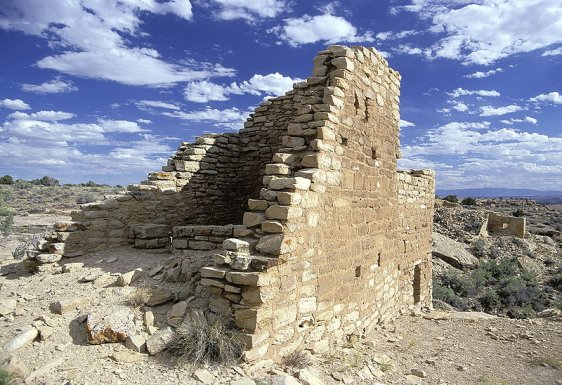Hovenweep National Monument is a cultural heritage site straddling the border of Colorado and Utah. It covers Montezuma County in Colorado and San Juan County in Utah. The nearest city is Bluff, Utah. The site is 785 acres (3 sq km) and was established by President Warren G. Harding on 2 March, 1923. It was added to the National Register of Historic Places on 15 October, 1966.
 Hovenweep National Monument, Colorado/Utah
Hovenweep National Monument, Colorado/UtahSource: https://commons.wikimedia.org/wiki/File:Cajon01-1.jpg
Author: Huebi

Hovenweep National Monument preserves six clusters of Native American ruins, four in Colorado and two nin Utah. The ruins in Colorado are Holly Canyon, Hackberry Canyon, Cutthroat Castle and Goodman Point, while the two in Utah are Square Tower and Cajon. There is a basic park headquarters located at Square Tower.
The Hovenweep ruins were first discovered in 1854 by Mormon colonists led by WD Huntington. It was given the name Hovenweep, which means "deserted valley" in the Piute/Ute language by pioneer photographer William Henry Jackson in 1874. A detailed survey of the ruins was carried out in 1903 by T. Mitchell Pruden, who reported intentional damaged caused by early collectors in search of buried treasures.
Visiting Hovenweep National Monument, Colorado
From either Blanding to the north or Bluff to the south, take US Highway 191 to Hovenweep Rd (Route 262). The site is open all year round though the visitor center is closed on Thanksgiving Day, Christmas Day and New Years Day. Opening hours are from 8:00 am to 6:00 pm from April through September and 8:00 am to 5:00 pm from October through March. Entrance fee is $3.00 per person, valid for 7 days. Latest updates on Penang Travel Tips
Latest updates on Penang Travel Tips

Copyright © 2003-2025 Timothy Tye. All Rights Reserved.

 Go Back
Go Back